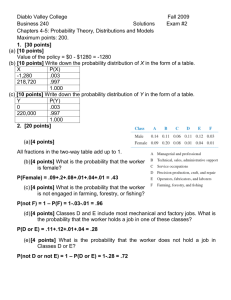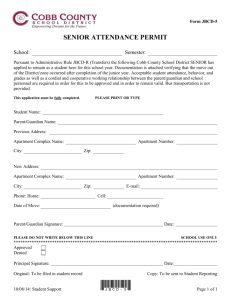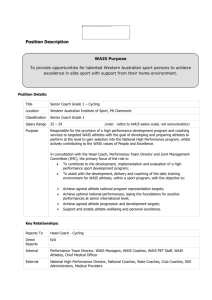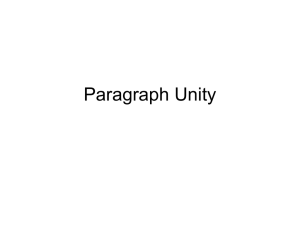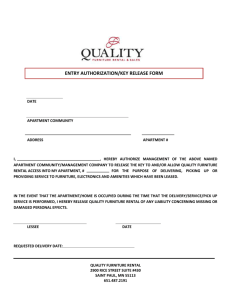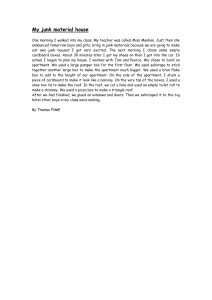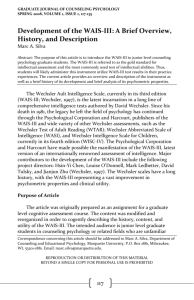The Relationship between Decision Making, Working Memory, and
advertisement
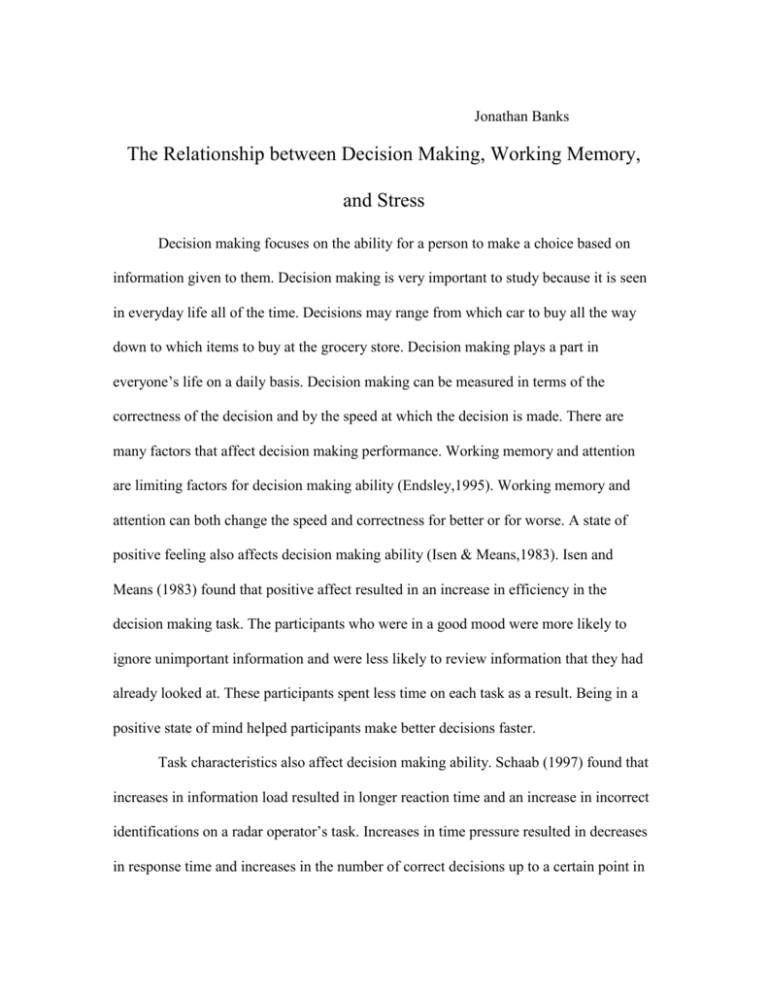
Jonathan Banks The Relationship between Decision Making, Working Memory, and Stress Decision making focuses on the ability for a person to make a choice based on information given to them. Decision making is very important to study because it is seen in everyday life all of the time. Decisions may range from which car to buy all the way down to which items to buy at the grocery store. Decision making plays a part in everyone’s life on a daily basis. Decision making can be measured in terms of the correctness of the decision and by the speed at which the decision is made. There are many factors that affect decision making performance. Working memory and attention are limiting factors for decision making ability (Endsley,1995). Working memory and attention can both change the speed and correctness for better or for worse. A state of positive feeling also affects decision making ability (Isen & Means,1983). Isen and Means (1983) found that positive affect resulted in an increase in efficiency in the decision making task. The participants who were in a good mood were more likely to ignore unimportant information and were less likely to review information that they had already looked at. These participants spent less time on each task as a result. Being in a positive state of mind helped participants make better decisions faster. Task characteristics also affect decision making ability. Schaab (1997) found that increases in information load resulted in longer reaction time and an increase in incorrect identifications on a radar operator’s task. Increases in time pressure resulted in decreases in response time and increases in the number of correct decisions up to a certain point in which the response time increases and number of correct responses decreased. The participants were simply over loaded and could not handle any more pressure. Working memory plays a large part in decision making. Working memory can only hold and process so much information at one time and that time span is limited. If people must make a decision, they must use information to base the decision on. This information must be stored in working memory. The better a person’s working memory then the better and the faster they should make their decision. Tucker and Warr (1996) found that working memory span and processing time were negatively correlated with each other and both were strongly predictive of the proportion of correct decisions. The lower someone’s working memory, the longer it took for that individual to process the information. The higher the person’s working memory the greater the proportion of correct answers they gave. Reber and Kotovsky (1997) had participants solve the Balls and Boxes puzzle while listening to a stream of letters and beeps. When participants heard the beep they had to write down the last one, two, or three letters that they heard, depending on the condition. The more letters that they were instructed to remember the greater the load on working memory. The participants completed the task twice. On the first trial the greater the number of letters that they had to remember, the more moves required to solve the puzzle. There was no difference in the working memory load and the number of moves needed to solve the second puzzle. This suggests that while learning how to solve a puzzle or task, high working memory loads can impair decision making, but once someone has learned how to solve the puzzle the working memory load may not be as important. Stress can affect cognitive processes such as working memory. Klein and Barnes (1994) found that life stress and state anxiety have the ability to consume cognitive resources, such as working memory. If stressful events are consuming a large part of working memory capacity, then the ability to use working memory for other things such as decision making is greatly reduced. Paulman and Kennelly (1984) found that high exam-skilled, high-anxiety students perform comparably with unskilled, low-anxiety students. High skill level can help compensate for high anxiety. The better the participant’s skills the better they were able to cope with high stress. This is similar to what Reber and Kotovsky (1997) found with learning. Once the problem solving strategy had been figured out the better they dealt with stress. Moderate amounts of stress can sometimes be good. Too much stress on the other hand is bad. Schaab (1997) found that with increased time pressure performance increased up to a certain point and then decreased. Endsley (1995) found that individuals, who were under stress from stressors such as boredom, fatigue, fear, mental load, or time pressure, were more likely to arrive at a decision without exploring all information available to them. This can obviously be a costly mistake and can lead to incorrect decisions. The present study examined the relationship between decision making, working memory, and stress. The hypothesis is that increased stress levels will lead to lower working memory levels and, in turn, lower working memory levels will lead to increased time spent on the decision making task and more incorrect answers on that task. METHODS SUBJECTS Twenty-five introductory psychology students participated in this study. In return for participation they received partial credit for their introduction to psychology class. MATERIALS WAIS backward digit span task. The WAIS backward digit span task was used to measure working memory. This is part of the Wechsler Adult Intelligence Scale-Third Edition (Wechsler, 1997). Participants were shown a series of numbers and letters, on a computer screen, and asked to orally recall the numbers first, from lowest to highest, and then letters in alphabetical order. The participants were given six short practice trials before beginning. The set sizes started at two items, one number and one letter. The series of numbers and letters increased by either one number or one letter as long as they correctly answered one in a set of three. Participants were given three trials at each set size. If they did not get any correct in a set then the task was ended. Decision Making Task. The decision making task was a modified version of the task used by Isen and Means (1983). Participants were shown four matrixes of information. Two about cars and two about apartments. The matrices were presented on the computer screen. Each matrix contained five different choices and five pieces of information about each choice. The matrices containing the apartments showed information about the distance from campus, in minutes, the rent per month, the deposit, the square feet, and the utility bill for each apartment. The matrices containing the cars showed information about fuel economy, purchase price, cost of insurance, maintenance cost per year, and resale value for each car. Sample matrices can be found in figure 1. Participants completed two such matrices for cars and two such matrices for apartments. Participants selected the car or apartment that was the best choice and entered the letter of the choice, A though E, on the keyboard. For scoring the task, each piece of information was ranked from one to five based on the other pieces of information in the same category, with one being the best and five being the worst. A car that got thirty-nine miles per gallon, being the best, would be rated with a one while a car the got twenty-five miles to the gallon, being the worst, would get a rating of five. The ratings for each car or apartment were then summed and the car or apartment with the lowest summed rating would be seen as the correct choice. Each participant answers were scored as 1(correct) or 0(incorrect). The total number of correct answers and the average response time for the matrices were used to score the decision making task. Stress inventory. Participants completed a survey of stressful events in their life designed by Sarason, Johnson, and Siegel(1979). Participants rated each stressful experience on the positive or negative impact that the event had upon them. The events were rated from negative three to a positive three. Two scores were calculated for this task. One was the number or frequency of stressful experiences and the other was the intensity or summed rating for the impact the event had upon the participant. PROCEDURE Participants were tested individually in a laboratory. Participants signed informed consent forms and then began the experiment. Participants began by either completing the decision making task and then the WAIS or by completing the WAIS and then the decision making task. Participants then completed either the cognitive failures questionnaire and then the stress inventory or the stress inventory and then the cognitive failures questionnaire. At the end of the study participants were debriefed and thanked for their participation. RESULTS Stress scores and WAIS scores were correlated to try to reproduce findings by Klein and Barnes (1994) that stress can impair cognitive processes such as working memory. The correlation between frequency of negative events on the stress inventory and the WAIS approached significance, r (23)=-.238, p <.13,one tailed test. The correlation between intensity of negative events on the stress inventory and the WAIS was significant, r (23)=-.329, p <.05. Both of these correlations are in the right direction with greater stress being associated with lower working memory levels. A correlation between scores on the WAIS and the number of correct answers on the decision making task approached significance, r (23)=.222, p <.15. This is what would be expected if working memory plays a role in decision making ability. There was no relationship between the WAIS scores and the average response times on the decision making task. The reported intensity of negative events and the reported frequency of negative events were very highly correlated, r (23)=.923, p <.05. DISCUSSION The results supported the hypothesis that stress impairs working memory and that reduced working memory capacity hampers decision making ability. The frequency and intensity of negative events negatively correlated with the WAIS scores. The greater and more stressful the events that occurred the smaller the working memory capacity. The WAIS scores and the number correct on the decision making task were also correlated, indicating that increased working memory positively affects decision making ability. More participants will be run to increase the power of the statistical test. It makes sense that the greater the working memory capacity people have the better they should be able to make decisions. If people can keep track of information then they will not have to keep looking back to refresh their memory or risk losing the information. People will be able to make the decision based on more information if they can remember the information. People should be able to make better decisions if they have more information. If people are able to remember the price of an item then they will be better able to compare prices of other brands. Making large decisions such as buying a car are very important. If someone is able to manage a lot of information at one time then it might help make the decision more easily made and more correctly made. CONCLUSION The hypothesis that stress impairs working memory and that reduced working memory capacity limits decision-making ability was supported by the results. This has real world applications for everyday events. If people need to make an important decision it would be best if it were made at a time when they are not under large amounts of stress. Table 1. Means, standard deviations and correlations between variables, n = 25 WAIS Frequency Intensity Number Average of Stress of Stress Correct Response Means Standard Deviation Decisions Time WAIS -0.329* 0.222 0.029 13.320 2.868 0.923** 0.142 0.144 5.400 2.693 0.178 0.179 8.440 4.620 0.138 2.160 1.028 Average 39937 12784 Response msec msec Frequency of -0.238 Stress Intensity of Stress Number Correct Time *p < .05 **p < .01 Figure 1. Sample Decision Making Matrices Apartment A Apartment B Apartment C Apartment D Apartment E Distance from Campus 24 minutes 8 minutes 31 minutes 13 minutes 17 minutes Rent $ 150 per $500 per $175 per $365 per $380 per month month month month month Deposit $150 $220 $55 $80 $120 Square Feet 1,120 sq. ft. 760 sq. ft. 890 sq. ft. 1,000 sq. ft. 1,200 sq. ft. Utility Bill $80 $220 $300 $100 $175 Car A Car B Car C Car D Car E Fuel Economy 25 miles per gallon 35 miles per gallon 31 miles per gallon 29 miles per gallon 39 miles per gallon Purchase Price Cost of Insurance $21,000 $14,000 $570 $1,340 $380 $720 $990 Maintenance Cost $125 per year $150 per year $75 per year $50 per year $100 per year Resale Value $15,000 $12,000 $16,000 $21,000 $25,000 $11,000 $18,500 $27,000 References Endsley, M.R.(1995). Toward a theory of situational Awareness in Dynamic Systems.Human Factors,37,32-64. Isen, A.M. & Means, B.(1983). The influence of positive affect on decision-making strategy. Social Cognition, 2, 18-31. Klein, K. & Barnes, D. (1994). The relationship of life stress to problem solving: Task complexity and individual differences. Social Cognition, 12, 187-204. Paulman, R.G. & Kennelly, K.J. (1984). Test anxiety and ineffective test taking: Different names, same construct? Journal of Educational Psychology, 76, 279288. Reber, P.J. & Kotovsky, K. (1997). Implicit learning in problem solving: The role of working memory capacity. Journal of Experimental Psychology: General, 126, 178-203. Sarason, I.G., Johnson, J.H. & Siegel,J.M. (1979). Assessing the impact of life changes: Development of the life experiences survey. Journal of Consulting and Clinical Psychology, 46, 932-946. Schaab, B.B. (1997). The influence of time pressure and information load on rule-based decision-making performance. Dissertation-Abstracts-International: Section-B: The Sciences and Engineering,58,2713. Tucker, P. & Warr, P. (1996). Intelligence, elementary cognitive components, and cognitive styles as predictors of complex task performance. Personality and Individual Differences, 21, 91-102. Wechsler, D.(1997). Wechsler Adult Intelligence Scale- Third Edition. San Antonio, TX: Psychological Corporation.
